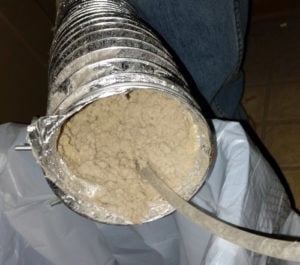A clogged Pipe�has a buildup of lint and other debris.
 Our Clogged dryer vent
Our Clogged dryer vent
Homeowners with today’s modern laundry rooms find clothes dryers almost anywhere in the home, creating very long vents and clogged dryer vents.
Your�Duct Work has�complicated runs that have several bends.
Clogged dryer vents tend to create backpressure, and the dryer�s efficiency is degraded.
Accordingly, homeowners with long clothes dryer vents will collect lint more rapidly than dryer ducts with shorter runs and fewer turns; this is what clogs vents.
What are the Causes of Dryer Vent Clogging?
Customers with clothes dryer ducts longer than 25 feet should consider annual cleanings because a�Clogged Dryer Vent can cost you more to operate your dryer.�RESIDENTIAL DRYER VENTS
Faulty hookups cause hazards, and dryer vents made of flexible plastic occur.
As a result of pushing, the dryer gets moved back against the wall and crushed. With this in mind, the dryer duct material is more likely to sag. That’s why we recommend ridge metal or UL-approved flexible metal ducts. For the dryer vent, all connections should be made with aluminum foil tape.
Dryer vents should not have screws or duct tape. Screws catch lint, and the tape will dry out and be useless.
Considering this, using screens or cages at the Dryer duct termination point outside your home will prevent animals from getting in; consequently, you’ll need to check frequently for lint buildup.
Homeowners who clean the clothes dryer vent screen will get proper airflow. Good airflow is approximately 15 MPH up to 20 MPH at the exit outside your home.
Want to learn more? Please call The Lint Kink at 847-874-4805 or visit us online at�TheLintKing.com.
The Lint King – Dryer Vent Cleaning Experts
Dryer Vent Cleaning Cost
Our Dryer Vent Cleaning� Reviews
Dryer Vent Cleaning Coupons
Schedule a Dryer Vent Cleaning
Clothes Dryer FAQs
Comprehensive Guide to Cleaning Your Dryer Vent Safely and Efficiently
Laundry Room Maintenance
Local Dryer Vent Company